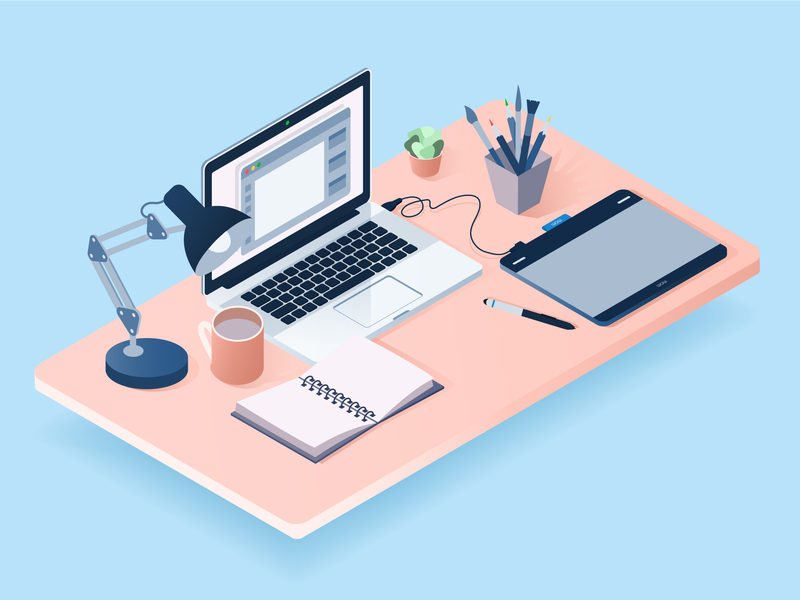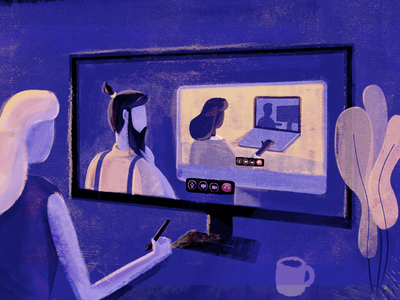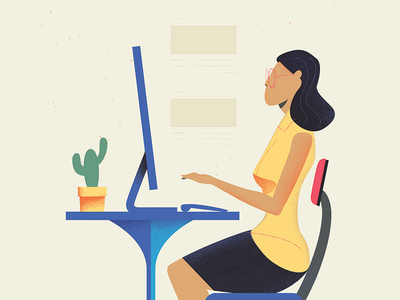Luke Pettit, Content Writer for Remote-How, dissects the factors all remote workers should consider when setting up their home office for success:
With so many designers now working from the comfort of their own homes, it’s worth making sure that your set up is conducive to the great work you’re shipping. There are a handful of different aspects you’ll need to think about in order to work at your best and avoid the common pitfalls of working remotely.
First thing’s first: for a productive home office you have to make a clear distinction between your working space and other areas you use for winding down or relaxing. You may also need to think about the possibility of clients visiting your home, family interruptions, or noise levels. Although it may seem fairly simple to pick an area to work from, there can actually be a lot of different factors that play into creating an ideal home workspace. We’ll look into each of these factors and offer our tips to help set you up for remote success!
Row 1: Samker for RaDesign, Olga Hmelevskaya, Alex Pasquarella for Canopy.
Where to plant down
We recommend that you find the optimum spot by utilizing the Ds: demands, distractions, dimensions, and desirability.
Demands include having a suitable area for visiting clients (if that’s part of your job), access to a physical connection with your router, and an appropriate place for making video or conference calls.
Distractions should also be taken into consideration. If you share your home during the working day with family members or housemates, distractions can occur. Think about where you are least likely to be interrupted, but also fulfills any demands that are required for your working space.
Dimensions are also important, as you may need more space for certain jobs and tasks. When working with just a laptop, it can be easy to make do in smaller areas. However, things can easily become cluttered when working with physical documents or materials. Having enough space for all the tools you need as a designer is important, especially when working with physical materials and not just within software. You’ll probably need more space than you think! Also make sure that you feel physically comfortable in your home office, aren’t too cramped, and have enough room to breathe and stretch.
Desirability is another aspect to consider when choosing your space. You may have a certain room that gets better sunlight or has a nicer view. Choosing somewhere desirable is likely to have a positive impact on your productivity and also your mental well-being.
You’ll probably struggle to try and fulfill every requirement when setting up your home office space. Try to strike a balance between the demands that have to be met and the other factors that will make your desk a pleasant place to work!
Choose the right equipment
Once you’ve chosen your space, it’s time to get it fit with all the equipment you’ll need to successfully work from home. The most important piece of furniture is the one you’ll probably use most—your desk chair.
The benefits of choosing an ergonomic and comfortable chair are well-known. You can reduce back pain, improve posture, and prevent long term work-related injuries. You can improve your productivity by being less distracted from uncomfortable seating positions. Also take into consideration the height of your desk, which should be at a suitable position in comparison to your chair. Your arms should rest on the desk at a comfortable height without causing any change in your back position.
Another important piece of equipment designers will need to look into is a monitor. Don’t just run out and buy the cheapest one you can find. Some things to consider when picking a monitor include color and grayscale accuracy, resolution, and the size you may need. Also having your own digitizer will be important if you’ve had to rely on using one in an office before.
Other pieces of equipment to think about are video-conferencing technology such as a microphone or webcam for talking with clients, proper lighting, and other office basics you may need like pens, paper, and filing systems. A decent router and ethernet cable for a direct connection are also recommended to ensure that all video conferences happen seamlessly.
Row 1: Mike Piechota for Netguru, Cécile L. Parker, Pawel Granatowsky.
Figure out what lighting works best
There are three types of light to consider when setting up your home office: natural, ambient, and task.
Natural light is, of course, one particularly good way of lighting your home office, but cannot be used all the time. At certain points of the day, you may experience glare or not have enough natural light to complete a particular task easily. Try to think about specific times that you are able to utilize sunlight to its the best ability by either installing blinds to avoid glare, or supplemental lighting methods for early morning or late at night.
Task lighting consists of smaller, more concentrated sources of light such as a desk or floor lamps. Another term for this is office lighting. For tasks where concentration is needed, (i.e. design work on your computer or completing focused tasks), a targeted source of lighting will help with concentration. We recommend using them in contrast, so when working with a task light try to keep other lighting in the room at a lower level. This will reduce overall glare and help improve concentration. This lighting is so important for making sure you can accurately see your screen and that colors are represented well.
Last of all is ambient lighting, which provides a whole room with a more gentle glow rather than directed at any source. It can either help create a more relaxed environment within the room, enhance the natural light already coming in, or be used as a base to build on with task lighting.
With all these kinds of lighting, it’s important to think about what exactly your requirements are. The lighting you choose should ultimately help keep you alert and also awake. If you find that your productivity suffers from your lighting choice, then it’s worth exploring some of the different options that have already been discussed. One of the key things to make sure you get right is avoiding eye strain, as working with a screen for long hours can be detrimental to your eyesight. It’s fairly easy to create an inspiring environment with your lighting, so it’s worth experimenting until you find the right balance between comfort and productivity.
One of the major benefits of remote work is being able to create a home office space that works for you. Unless you’re traveling while working, more often than not you have complete control over how your space looks and feels. A combination of lighting, equipment, and location all come together to create an office that can really work for you. By following all the tips we’ve provided, you should be well on your way to having a comfortable and productive space to complete your design work in!

Remote-how is an online platform empowering the growth of remote work through education, community support, and work & travel projects such as Remote-How Academy or Global Work From Home Day. This team of remote work lovers is also a driving force behind the Remote Future Summit 2019 - the biggest virtual conference about remote work featuring experts from remote friendly companies, including our very own Zack Onisko, CEO of Dribbble.
Find more Community stories on our blog Courtside. Have a suggestion? Contact stories@dribbble.com.

















